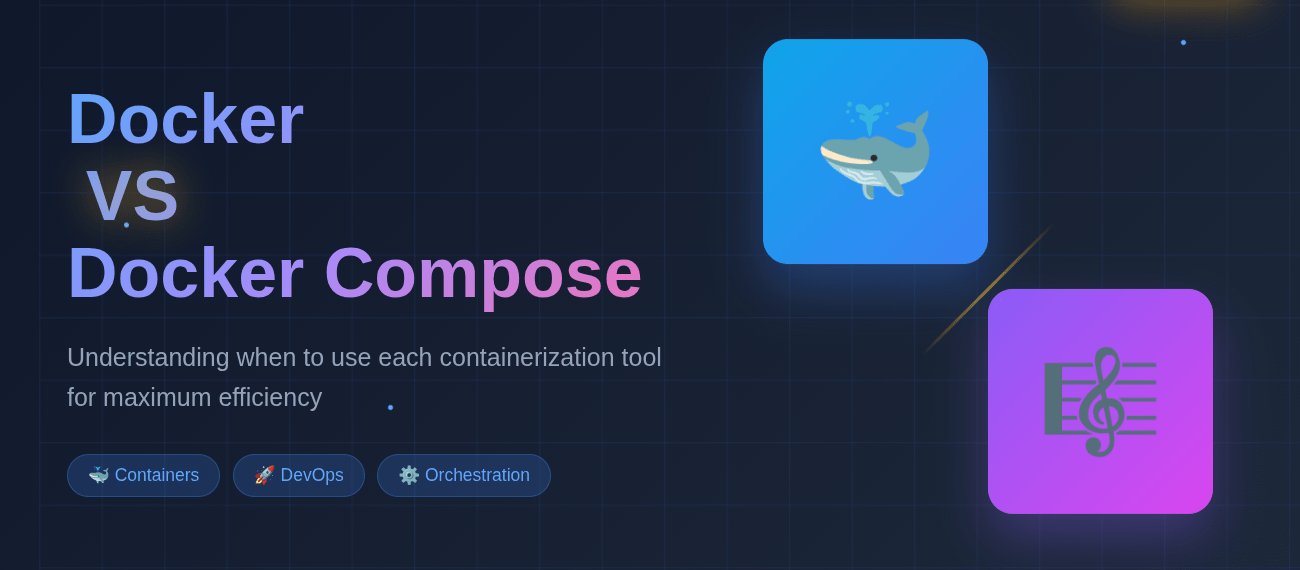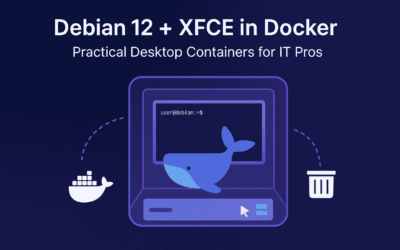Introduction
As containerization continues to dominate the modern infrastructure landscape, Docker has become synonymous with container technology. However, many IT professionals still find themselves puzzled by the relationship between Docker and Docker Compose. Should you use one or the other? When does each tool shine? Let’s dive deep into understanding both technologies and their optimal use cases.
What is Docker?
Docker is a containerization platform that packages applications and their dependencies into portable containers. Think of it as a lightweight alternative to virtual machines, where each container shares the host’s kernel but runs in isolation. Docker revolutionized software deployment by solving the age-old “it works on my machine” problem.
At its core, Docker provides several key capabilities. It creates isolated environments for applications using Linux namespaces and cgroups, ensuring process isolation, network segmentation, and resource management. Docker images serve as immutable templates that contain everything needed to run an application: code, runtime, libraries, and system tools. These images follow a layered filesystem approach, making them efficient in terms of storage and transfer.
The Docker daemon manages the entire container lifecycle, from pulling images from registries to managing running containers. When you execute commands like docker run nginx, you’re interacting with this daemon through the Docker CLI, instructing it to create and manage container instances.
What is Docker Compose?
Docker Compose is an orchestration tool that simplifies managing multi-container Docker applications. While Docker focuses on individual containers, Docker Compose takes a broader view, allowing you to define and run applications consisting of multiple interconnected services using a single YAML configuration file.
The beauty of Docker Compose lies in its declarative approach. Instead of remembering complex docker run commands with numerous flags and parameters, you describe your desired application stack in a docker-compose.yml file. This file becomes your single source of truth, documenting your application’s architecture, networking requirements, volume mounts, and environment configurations.
Docker Compose handles the orchestration complexity behind the scenes. It creates networks for service communication, manages dependencies between containers, handles volume creation and mounting, and provides simplified commands for managing the entire application stack. With a single docker-compose up command, you can spin up an entire development environment consisting of web servers, databases, cache systems, and message queues.
Key Differences: Architecture and Approach
Understanding the fundamental differences between Docker and Docker Compose helps in choosing the right tool for your needs. These differences span several dimensions that affect how you design, deploy, and manage containerized applications.
Scope and Purpose: Docker operates at the container level, focusing on building, shipping, and running individual containers. It’s the foundation that makes containerization possible. Docker Compose, conversely, operates at the application level, coordinating multiple containers to work together as a cohesive system. While Docker asks “How do I run this container?”, Docker Compose asks “How do I run this entire application?”
Configuration Management: With Docker, configuration is typically handled through command-line arguments or scripts. Each container requires its own docker run command with specific flags for ports, volumes, networks, and environment variables. Docker Compose consolidates all this configuration into a single YAML file, providing a more maintainable and version-controllable approach to infrastructure as code.
Networking Complexity: Docker requires manual network creation and container attachment for inter-container communication. You need to explicitly create networks and ensure containers are connected properly. Docker Compose automatically creates a default network for your application and handles DNS resolution between services, allowing containers to communicate using service names rather than IP addresses.
State Management: Docker treats containers as ephemeral by default, requiring explicit volume management for persistent data. Docker Compose makes it easier to define and manage both named volumes and bind mounts, ensuring data persistence across container restarts and updates.
Use Case Scenarios
- Docker:
- Ideal for running a single containerized application.
- Example: Running an Nginx container to serve static content.
- Useful for developers testing apps quickly on local machines.
- Docker Compose:
- Best for multi-container applications.
- Example: Running a WordPress stack (WordPress + MySQL + phpMyAdmin) with a single command.
- Allows developers and sysadmins to replicate production environments locally.
Security Considerations
- Docker containers share the host’s kernel — isolation is strong but not absolute.
- With Docker Compose, you must be careful when linking services. Misconfigured networks or open ports can expose sensitive services.
- Best practices include:
- Running containers as non-root.
- Using private networks in Compose (
networks:). - Employing secrets (
docker secretor.envfiles) instead of hardcoding credentials.
Dockerfile Example
A simple Dockerfile for a Python Flask app:
FROM python:3.11-slim WORKDIR /app COPY requirements.txt . RUN pip install -r requirements.txt COPY . . CMD ["python", "app.py"]
You can build and run this with Docker commands:
docker build -t flask-app . docker run -p 5000:5000 flask-app
Docker Compose Example
Full stack application:
version: '3.8'
services:
frontend:
image: node:16-alpine
working_dir: /app
volumes:
- ./frontend:/app
command: npm run dev
ports:
- "3000:3000"
depends_on:
- backend
backend:
build: ./backend
environment:
DATABASE_URL: postgresql://user:pass@db:5432/myapp
REDIS_URL: redis://cache:6379
ports:
- "8080:8080"
depends_on:
- db
- cache
db:
image: postgres:14
environment:
POSTGRES_PASSWORD: pass
POSTGRES_USER: user
POSTGRES_DB: myapp
volumes:
- db_data:/var/lib/postgresql/data
cache:
image: redis:7-alpine
volumes:
db_data:
Run it with one command:
docker-compose up -d
This Docker Compose configuration defines an entire application stack with frontend, backend, database, and cache services, all configured to work together seamlessly.
Why You Need to Learn Both
- Docker gives you the building blocks to containerize and ship applications.
- Docker Compose gives you orchestration for real-world, multi-service systems.
- Learning both means:
- Faster development cycles
- Easier CI/CD pipelines
- Scalable testing environments
- Improved collaboration between Dev and Ops teams
In short, Docker = foundation and Compose = accelerator. Together, they’re essential for every IT professional.
Container Orchestration Evolution
The containerization landscape continues to evolve rapidly. Docker remains the foundational technology, constantly improving with features like BuildKit for faster builds and rootless mode for enhanced security. Docker Compose has evolved to support newer specifications like the Compose Specification, enabling better portability across different container platforms.
The industry trend points toward Kubernetes for production orchestration, but Docker and Docker Compose maintain their relevance. Docker serves as the container runtime underneath most Kubernetes deployments, while Docker Compose remains invaluable for development and testing. New tools like Podman and containerd offer Docker alternatives, but the concepts remain largely the same.
Cloud providers increasingly offer managed container services that abstract away orchestration complexity. Services like AWS ECS, Google Cloud Run, and Azure Container Instances blur the lines between simple container deployment and full orchestration, often supporting Docker Compose files directly.
Final Thoughts
Docker and Docker Compose aren’t competitors — they complement each other. Docker teaches you the fundamentals of containerization, while Compose scales that knowledge into multi-container environments.
If you’re serious about DevOps, cloud, or modern application deployment, start learning both today. Your future self (and your team) will thank you.




